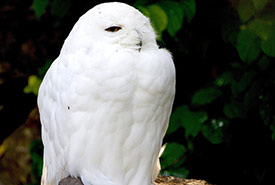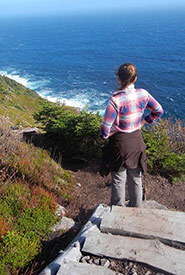Hiker meets hunter: An encounter with a snowy owl

A male snowy owl (Photo by Pixabay)
When I moved to Newfoundland in 2011, I was excited to explore the incredible landscapes of my adopted province. Even the most densely populated part of the province — the Avalon Peninsula near St. John’s — is still wild enough to support plenty of wildlife, at least compared to other Canadian capital cities.
It’s not unheard of for moose to wander through the Tim Horton’s drive-through in St. John’s! But to enjoy wildlife closer to their native habitat, I loved to hike the East Coast Trail, an amazing 300-kilometre trail that hugs the coastline of the Avalon Peninsula. From the vantage point of this trail, it’s possible to see whales and icebergs in the spring, stumble upon the occasional moose, or spot dozens of species of birds.
Related content

Dramatic landscape of the East Coast Trail. This location is near where the snowy owl was spotted. (Photo courtesy of Lanna Campbell/NCC staff)
It was while hiking on the East Coast Trail with my husband that I had my first-ever encounter with a snowy owl. It was a crisp, clear, sunny November day. We were near Cape Spear and stopped at a high point to enjoy a thermos of hot tea. While we were sitting on a rock, taking in the view of the valley below, we spotted a snowy owl. It was pure white (likely a male), and because of its large size and round shape, it was hard to miss. The owl was flying back and forth over a marshy area, hunting for its favourite Newfoundland food: mice, voles and rabbits.
At a metre tall, with a wingspan of up to a metre and a half, snowy owls are the largest of the six owls found in Newfoundland and Labrador, and one of the largest owls in the world. They breed in the high Arctic and nest by digging a bowl on the ground in tundra.
Snowy owls typically produces five to 10 eggs, but if food is abundant, they may lay as many as 14 to 16. During breeding, snowy owls rely on lemmings, a small rodent, for food. With few predators, food shortages are their main threat. In winter, snowy owls migrate south in search of food, which is likely why we were lucky enough to spot one hunting on the East Coast Trail, near St. John’s.
As we watched the snowy owl in its pursuit of food, something strange happened. It took a break from hunting and flew near us, seemingly curious. In that moment, it was so quiet, we could hear the faint swooshing of its huge wings.
On days when the administrative tasks of conservation pile up, I like to recall my encounter with the snowy owl, the sound of its wings and our brief but shared curiosity about each other.
The snowy owl is one of 19 species featured in NCC’s gift giving campaign: Gifts of Canadian Nature. To learn more and to give the gift of conservation, click here.


